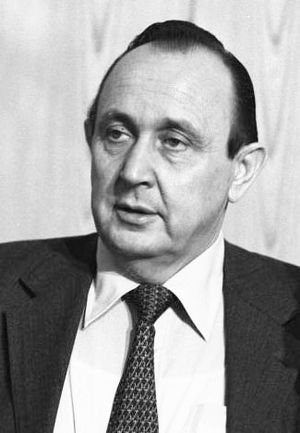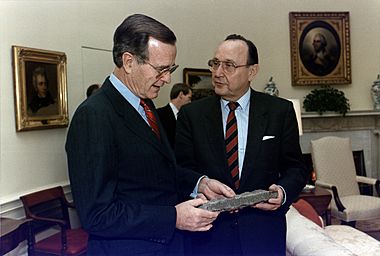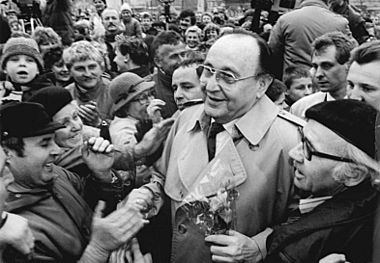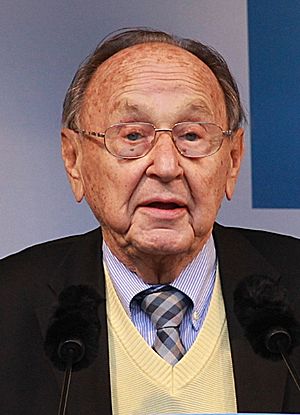Hans-Dietrich Genscher facts for kids
Quick facts for kids
Hans-Dietrich Genscher
|
|
|---|---|

Genscher in 1978
|
|
| Vice Chancellor of Germany West Germany until 1990 |
|
| In office 1 October 1982 – 17 May 1992 |
|
| President | Karl Carstens Richard von Weizsäcker |
| Chancellor | Helmut Kohl |
| Preceded by | Egon Franke |
| Succeeded by | Jürgen Möllemann |
| In office 17 May 1974 – 17 September 1982 |
|
| President | Gustav Heinemann Walter Scheel Karl Carstens |
| Chancellor | Helmut Schmidt |
| Preceded by | Walter Scheel |
| Succeeded by | Egon Franke |
| Federal Minister for Foreign Affairs | |
| In office 1 October 1982 – 17 May 1992 |
|
| Chancellor | Helmut Kohl |
| Preceded by | Helmut Schmidt |
| Succeeded by | Klaus Kinkel |
| In office 17 May 1974 – 17 September 1982 |
|
| Chancellor | Helmut Schmidt |
| Preceded by | Walter Scheel |
| Succeeded by | Helmut Schmidt |
| Leader of the Free Democratic Party | |
| In office 1 October 1974 – 23 February 1985 |
|
| Preceded by | Walter Scheel |
| Succeeded by | Martin Bangemann |
| Federal Minister of the Interior | |
| In office 22 October 1969 – 16 May 1974 |
|
| Chancellor | Willy Brandt |
| Preceded by | Ernst Benda |
| Succeeded by | Werner Maihofer |
| Member of the Bundestag for North Rhine-Westphalia | |
| In office 19 September 1965 – 26 October 1998 |
|
| Constituency | FDP List |
| Personal details | |
| Born | 21 March 1927 Reideburg, Prussia, Germany |
| Died | 31 March 2016 (aged 89) Wachtberg, Germany |
| Political party | Free Democratic Party of Germany (1952–2016) |
| Other political affiliations |
Nazi Party (until 1945) Liberal Democratic Party of Germany (GDR) (1946–1952) |
| Spouses |
Luise Schweitzer
(m. 1958; div. 1966)Barbara Genscher
(m. 1969) |
| Alma mater |
|
| Occupation | Politician |
| Signature | |
Hans-Dietrich Genscher (born March 21, 1927 – died March 31, 2016) was an important German politician. He was a member of the Free Democratic Party (FDP). Genscher served as the Federal Minister of the Interior from 1969 to 1974. Later, he became the Federal Minister for Foreign Affairs and Vice Chancellor of Germany from 1974 to 1992. He held these jobs for a very long time, longer than almost anyone else. He was also the only person to serve in these roles under two different German Chancellors.
Genscher was known for being a very skilled diplomat. Many people consider him a main "architect of German reunification". This means he played a huge part in bringing East and West Germany back together. He also helped with international talks when Yugoslavia broke apart. After leaving politics, he worked as a lawyer and international advisor.
Contents
Hans-Dietrich Genscher's Early Life
Genscher was born on March 21, 1927, in Reideburg, which is now part of Halle. This area later became East Germany. His father was a lawyer who passed away when Hans-Dietrich was nine years old.
In 1943, at age 16, he joined the Air Force Support Personnel during World War II. Near the end of the war, when he was 17, his army unit became members of the Nazi Party. Genscher later said he did not know about it at the time. After the war, he was a prisoner of war for two months.
From 1946 to 1949, he studied law and economics at the universities of Halle and Leipzig. In 1946, he joined the Liberal Democratic Party in East Germany.
Genscher's Political Career
In 1952, Genscher moved to West Germany. There, he joined the Free Democratic Party (FDP). He became a lawyer in Bremen in 1954. From 1956 to 1965, he worked for the FDP in different roles.
In 1965, Genscher was elected to the West German parliament. He remained a member of parliament until 1998. In 1969, he became the Minister of the Interior in a government led by Chancellor Willy Brandt.
In 1974, he took on the important roles of Foreign Minister and Vice Chancellor. He held these positions for 18 years. From 1974 to 1985, he was also the Chairman of the FDP party. In 1982, his party changed its support from the SPD to the CDU/CSU party. This led to Helmut Kohl becoming Chancellor. Genscher remained Foreign Minister and Vice Chancellor in this new government.
Federal Minister of the Interior
After the 1969 election, Genscher helped form the government with Chancellor Willy Brandt. He became the federal minister of the interior on October 22, 1969.
In 1972, during the Munich massacre at the Olympic Games, terrorists took athletes hostage. Genscher was the Interior Minister at the time. A rescue attempt by German police forces at an air base went wrong. This led to the tragic deaths of all eleven hostages, five terrorists, and one German policeman. Genscher's standing with Israel became difficult when he later supported releasing three captured attackers. This happened after a Lufthansa plane was hijacked in October 1972.
As Interior Minister, Genscher helped shape Brandt's policy of improving relations with communist East Germany and other Eastern Bloc countries. This policy was called Ostpolitik. He continued this important policy later when he worked with Chancellor Helmut Kohl.
Vice Chancellor and Federal Foreign Minister
As Foreign Minister, Genscher worked for peace and understanding between the East and West. He wanted to continue talking with the Soviet Union to reduce tensions. He was known for finding solutions to international problems through talks. People joked that he was so good at traveling and negotiating, "two Lufthansa jets crossed over the Atlantic, and Genscher was on both."

Genscher played a big part in writing the Helsinki Accords. These were agreements aimed at improving relations between countries. In 1976, the United Nations General Assembly accepted Genscher's idea for a convention against terrorism. This convention aimed to prevent countries from giving in to hostage-takers' demands.
In 1982, Genscher's party, the FDP, decided to switch its support. They moved from their partnership with the SPD to support the CDU/CSU. This change led to Helmut Kohl becoming Chancellor instead of Helmut Schmidt. This decision was debated a lot, even within Genscher's own party.
Sometimes, Genscher's approach was seen as too neutral by the United States and other allies. They wanted Germany to take a stronger stance. This approach was sometimes called Genscherism. It meant that Germany could act as a bridge between East and West while still being a loyal NATO ally. In the 1980s, Genscher did not support placing new NATO missiles in Germany.
In 1984, Genscher became the first Western foreign minister to visit Tehran since the 1979 Iranian Revolution. Genscher was also very active in developing the European Union. He helped with the Single European Act Treaty talks in the mid-1980s. He also worked with Italy's Foreign Minister, Emilio Colombo, on a plan for closer European cooperation. He strongly supported the idea of a shared European currency.
Genscher kept his jobs as Foreign Minister and Vice Chancellor through the time of German reunification. He stayed in these roles until 1992, when he stepped down due to health reasons.
Reunification Efforts
Genscher is highly respected for his efforts to end the Cold War and achieve German reunification. He worked to keep things stable between the West and the Soviet Union. He believed the West should work with communist governments, not just see them as enemies. Many Germans and Europeans agreed with this idea.
He strongly supported political changes in Poland and Hungary. He visited Poland in 1980 to meet with Lech Wałęsa, the leader of the Solidarity movement. From 1987, he pushed for an "active relaxation" policy towards the Soviet Union. He also kept strong ties with his hometown of Halle in East Germany.
In September 1989, thousands of East Germans sought refuge in West German embassies in Czechoslovakia and Poland. Genscher discussed this refugee crisis with foreign ministers from other countries at the United Nations. On September 30, 1989, Genscher made a famous speech from the balcony of the German embassy in Prague. Thousands of East Germans were in the courtyard, hoping to travel to West Germany. Genscher announced that they could leave. His words, "We have come to you to tell you that today, your departure...", were met with huge cheers.
Genscher, along with James Baker from the United States and Eduard Shevardnadze from the Soviet Union, helped ensure Germany's peaceful unification. They also arranged for Soviet forces to leave Germany. In 1990, he negotiated German reunification with Markus Meckel from East Germany. On September 12, 1990, he signed the Treaty on the Final Settlement with Respect to Germany for West Germany. He also signed a treaty with Poland in November 1990, confirming the Oder–Neisse line as Poland's western border.
After Reunification
In 1991, Genscher strongly supported Germany's recognition of Croatia and Slovenia. He believed that Yugoslavia could not stay together and that these republics deserved quick diplomatic recognition. He hoped this would help stop the fighting. Other European Union countries soon followed Germany's lead.
At a meeting in 1991, Genscher suggested a war crimes trial for Saddam Hussein of Iraq. He accused Hussein of attacking Kuwait and using chemical weapons.
During the Gulf War, Germany gave a lot of money to the allied forces. However, due to its constitution, Germany provided almost no military help. In January 1991, Genscher visited Israel and arranged for Germany to provide $670 million in military aid. This included Patriot missiles for defense against Iraqi missiles. Genscher famously said that Germany's military export policy for unstable countries was "whatever floats is fine, whatever rolls is not." This meant Germany would export naval vessels but not land vehicles that could be used against a country's own people.
In 1992, Genscher helped create the Council of the Baltic Sea States (CBSS). This organization promotes cooperation in the Baltic Sea region.
On May 18, 1992, Genscher retired from the government after 23 years. He was the world's longest-serving foreign minister at the time and a very popular politician in Germany. He had suffered two heart attacks, which likely influenced his decision. He remained a member of parliament and continued to be influential.
After Genscher's retirement, Klaus Kinkel became the new Foreign Minister.
Life After Politics
Even after leaving politics, Genscher remained active as a lawyer and in international organizations. From 1997 to 2010, he worked with a law firm. In 2000, he started his own consulting company. He also served as president of the German Council on Foreign Relations from 2001 to 2003. In 2001, he helped settle a dispute between the German airline Lufthansa and its pilots' union.
In 2008, Genscher joined Václav Havel, the former Czech President, and others to call for a Cold War museum in Berlin. In 2009, Genscher expressed concern when Pope Benedict XVI lifted the excommunication of some bishops. Genscher felt this decision might offend non-Catholics.
In 2013, Genscher played a key role in helping Mikhail Khodorkovsky, a former Russian oil executive, be released from prison and fly to Germany. Genscher had met Khodorkovsky years earlier. He worked with German Chancellor Angela Merkel to arrange meetings with Russian President Vladimir Putin. Genscher suggested Khodorkovsky write a pardon letter to Putin, mentioning his mother's illness. After Putin pardoned Khodorkovsky, Genscher provided a private plane to bring him to Berlin.
In 2014, Genscher became a member of the Southern Corridor Advisory Panel. This group works on expanding a natural gas field in the Caspian Sea and building pipelines across Europe.
Death
Hans-Dietrich Genscher passed away at his home in Wachtberg, Germany, on March 31, 2016. He was 89 years old.
Images for kids
-
George H. W. Bush and Genscher (November 21, 1989)
See also
 In Spanish: Hans-Dietrich Genscher para niños
In Spanish: Hans-Dietrich Genscher para niños







